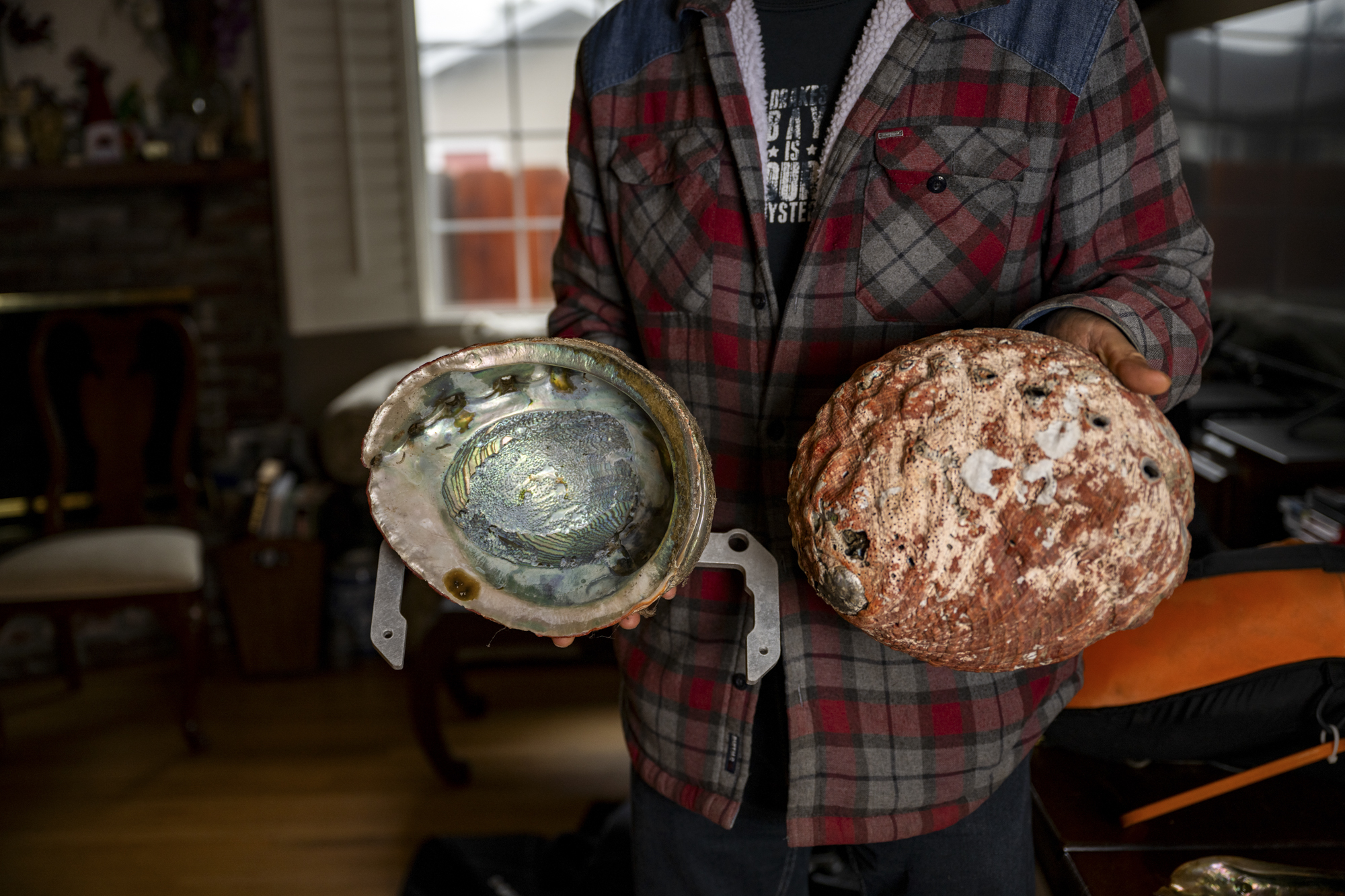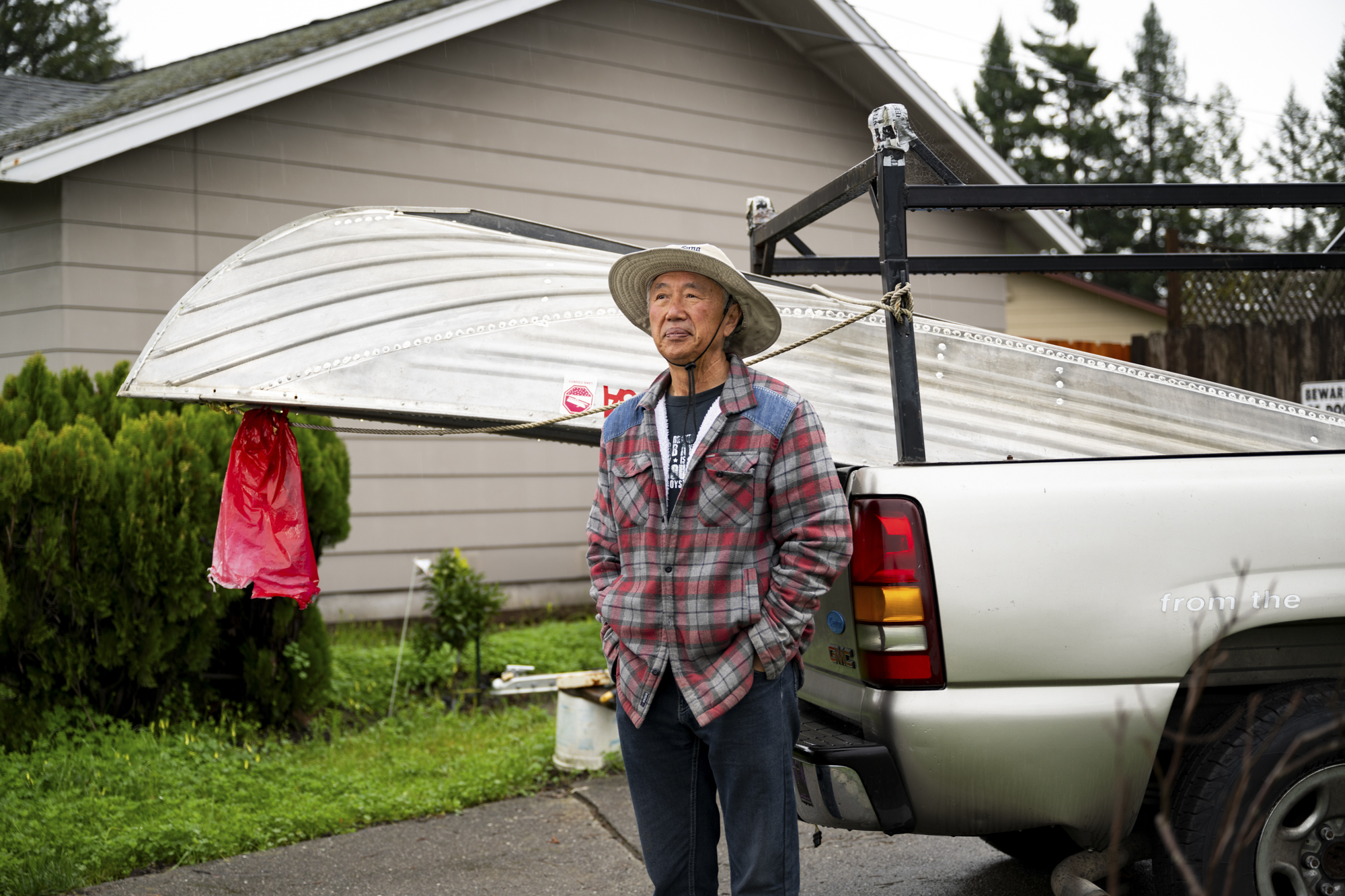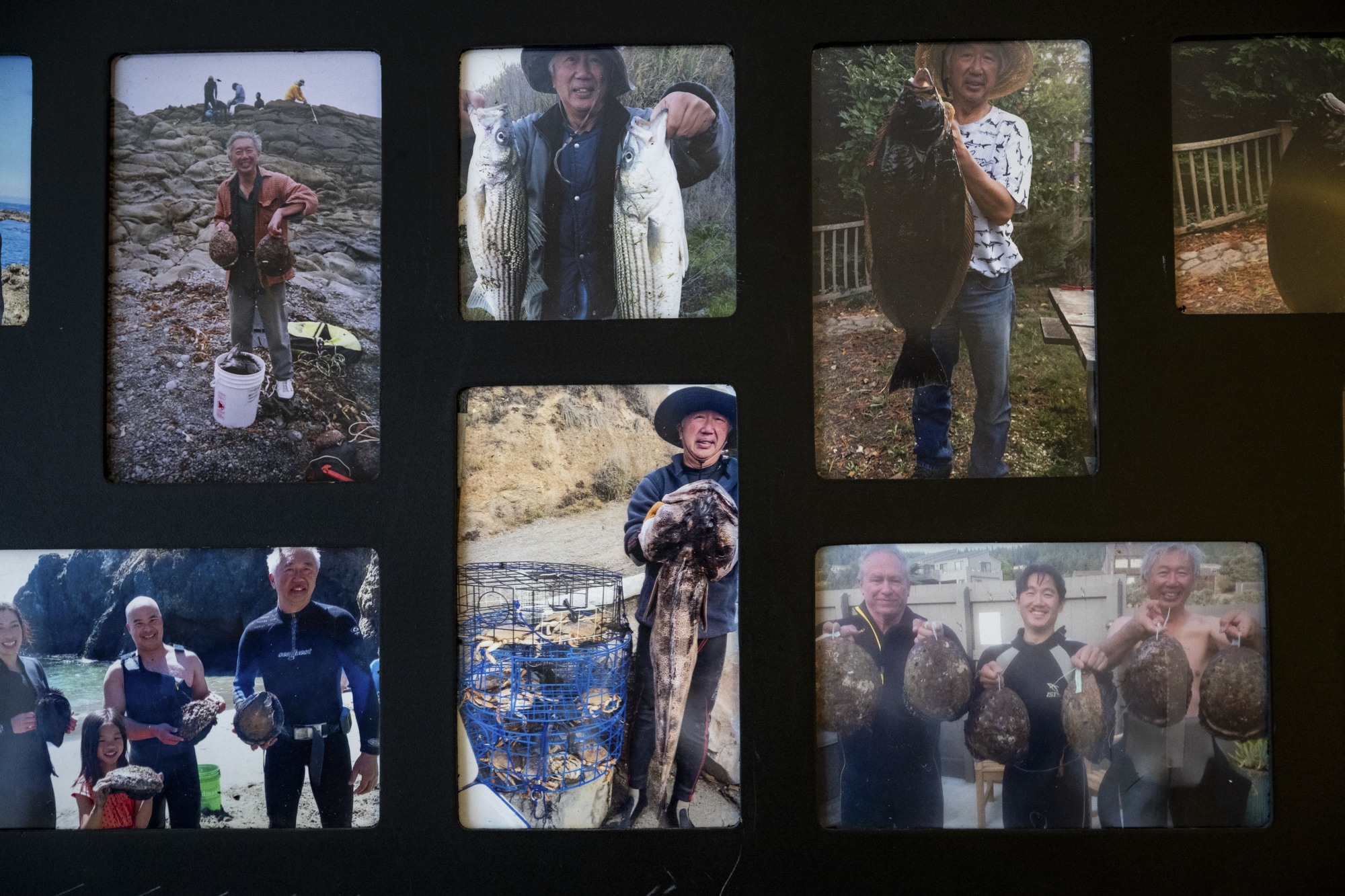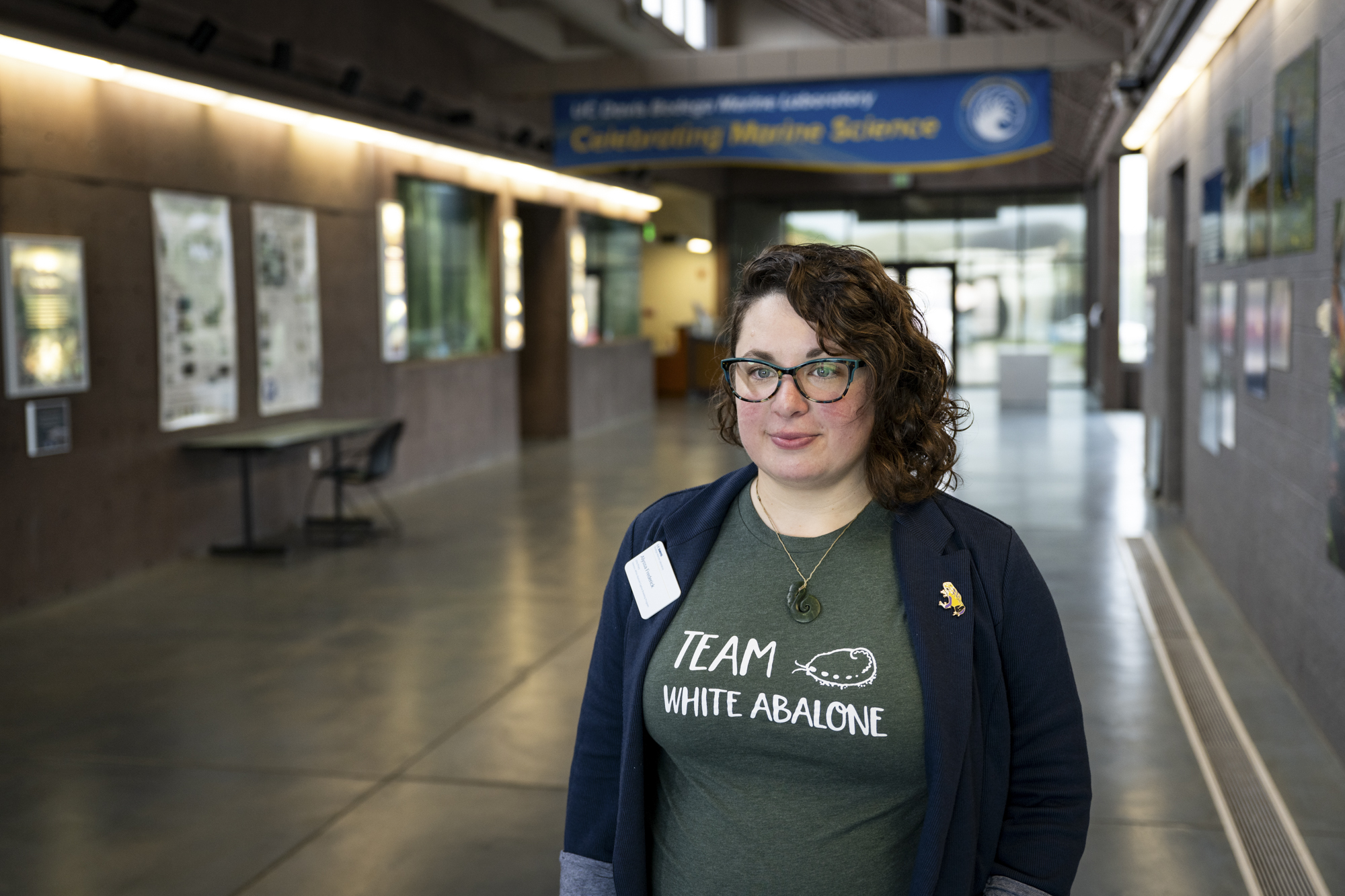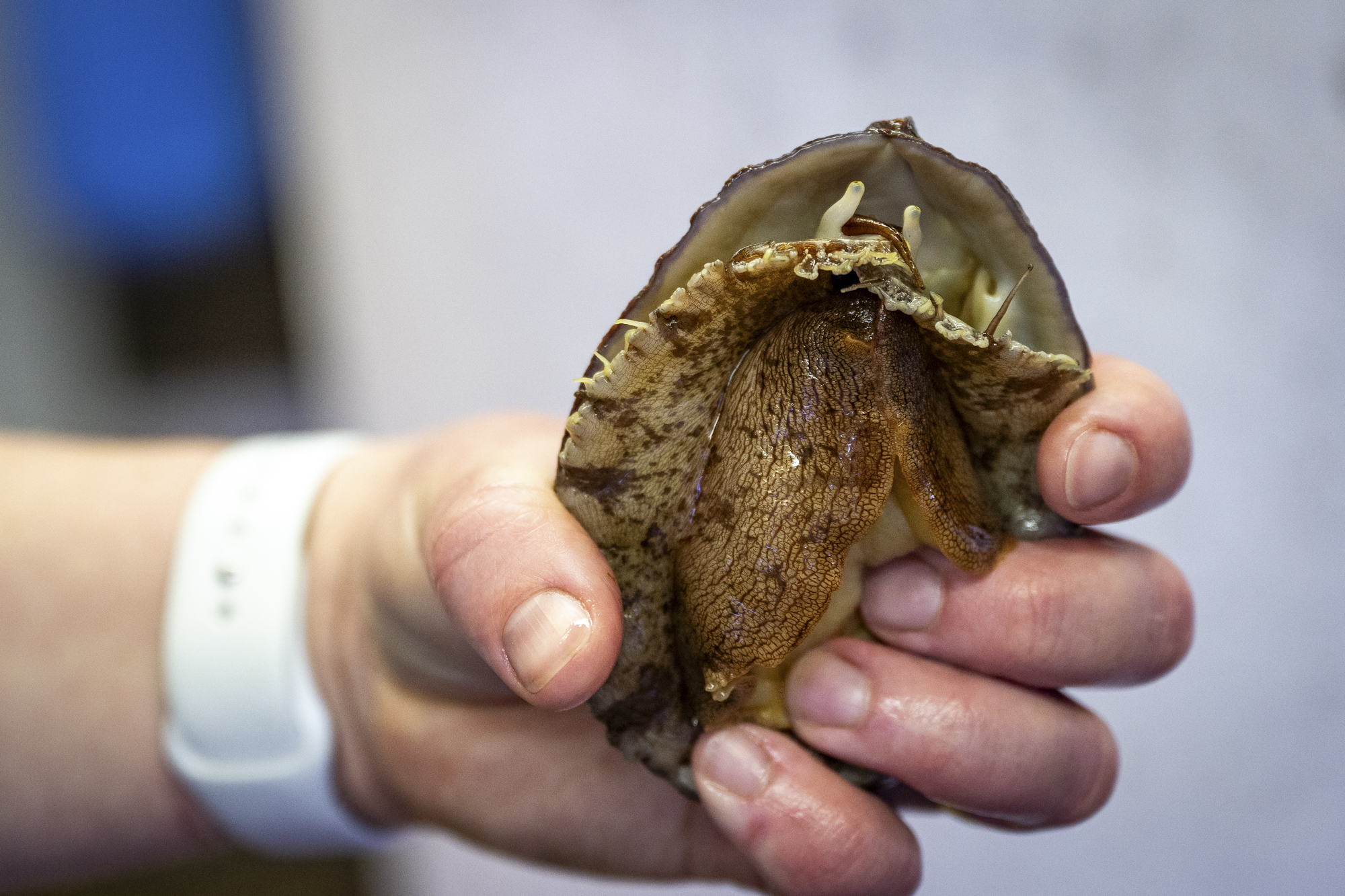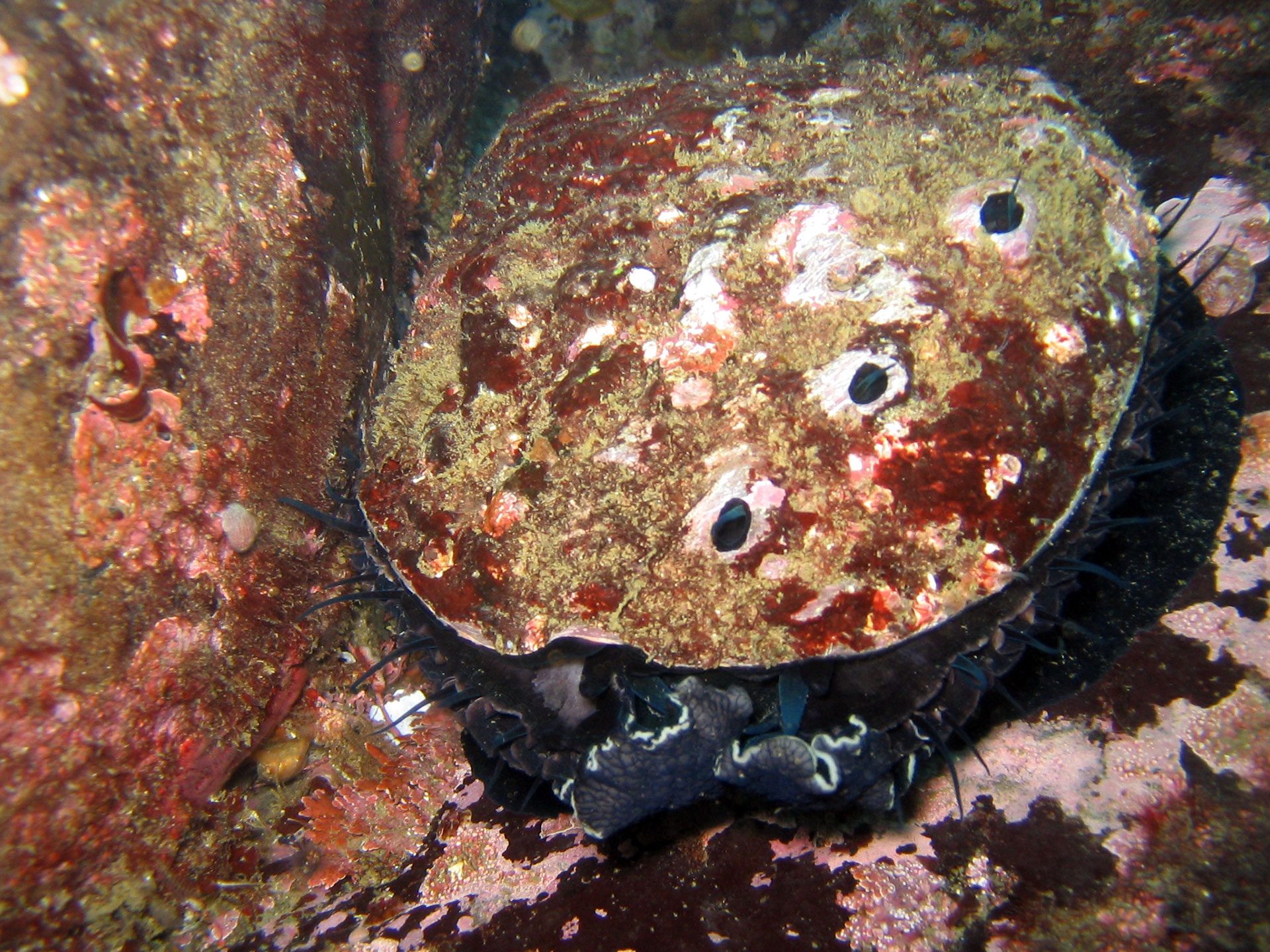Episode Transcript
[Sounds of ocean waves and seagulls]
Olivia Allen-Price: When Lorraine Page moved to Pescadero in the ’90s, she spent a lot of time at the beach. It was her way to unwind.
Lorraine Page: I’m a family doctor on the coast. So I’m busy. But on, on weekends and such, that would be an outlet for me.
Olivia Allen-Price: She would comb the beach and explore the tide pools for hours, looking for one thing in particular: abalone shells.
[Magical beach music begins]
Abalone are mollusks… basically big sea snails, up to 10 inches wide, that live off our northern California coastline. You might recognize their shells, which are iridescent… somehow every color of the rainbow all at once.
Lorraine sought them out because sometimes, if she was lucky, on those abalone shells she would find an abalone pearl.
Lorraine Page: They’re these beautiful little pearls that show up in the shell.
Olivia Allen-Price: When Lorraine found one, she’d bring it to a jeweler in Pescadero who would polish it up and turn it into a one-of-a-kind necklace or earrings. But over time, Lorraine has stopped finding them.
Lorraine Page: It used to be consistent that certain beaches in Pescadero, you’d find abalone shells, and I just can’t. They’re not around anymore.
Olivia Allen-Price: She says she hasn’t found a whole abalone shell in more than 10 years.
Lorraine Page: That’s just my simple question is, do we know why there’s not as many abalone?
[Bay Curious theme music starts]
Olivia Allen-Price: I’m Olivia Allen Price and you’re listening to Bay Curious. On today’s episode: what happened to all the abalone? And can we bring them back?
[Theme music ends]
Olivia Allen-Price: Where did all the abalone go? We sent reporter Dana Cronin to find out.
Dana Cronin: Before I get to answering Lorraine’s question, I think we could all use a little history lesson. Because, oh man, do abalone have a long history here in Northern California?
Ann Vileisis: Abalone have lived on the California coast for actually 70 million years, at the very least.
Dana Cronin: Ann Vileisis is an environmental historian who’s authored a whole book on abalone. She says the ancient mollusk has always held deep meaning for us Northern Californians… going back to the very first humans who lived here.
Ann Vileisis: When humans came to California, they started using abalone right away, initially for food, but soon thereafter also for tools.
Dana Cronin: Indigenous people also used abalone shells for decoration and ceremonial purposes.
[Sounds of a Pomo Indian dance performance featuring clacking abalone shells]
Dana Cronin: During ceremonial dances, for example… abalone shells were a part of the regalia. They not only looked beautiful — they also added this incredible clacking sound… bringing the dance to life.
But when European settlers arrived on the West Coast, they started treating abalone like a commodity… to be traded and sold.
[Music starts]
In the late 18th century, Spanish settlers traded abalone shells for sea otter fur as part of the Pacific fur trade.
Then, in the mid-to-late-1800s, Chinese and Japanese immigrants — who were very familiar with abalone being from the other side of the Pacific Ocean — began shipping dried abalone and shells back to China and Japan, where they were used in soups and congees.
Ann Vileisis: That was actually probably one of the, you know, among the first California global trades was in abalone.
Dana Cronin: This was also a time of extreme racism and xenophobia in the U.S., around when Congress passed the Chinese Exclusion Act, which barred Chinese immigrants from entering the U.S.
In 1913, the California legislature passed a ban on exporting abalone, which they said was due to concerns of overfishing. In reality, the ban was part of the larger anti-immigrant sentiment of the time.
[Music fades out]
But abalone fishing didn’t stop. And in fact, over time, more and more Americans realized how delicious these sea snails are.
Doug Jung: It is absolutely the best thing you can ever eat. There was nothing I’d rather eat than abalone. I mean, it was just so good.
Dana Cronin: This is Doug Jung. He lives in Santa Rosa and has been abalone diving up and down the Northern California coast since he was in high school — over 50 years.
He says abalone is naturally buttery and salty… and there’s something about its texture that is totally unique and delicious.
Doug Jung: We just pound it with a wooden mallet until it’s soft. And then we throw it in a wok for six minutes and deep fry it and it comes out. It doesn’t suck up all the oil. You have it covered with flour and things. So it’s crunchy on the outside. You can cut it with a fork easily.
Dana Cronin: Like, imagine the most tender, melt-in-your-mouth scallop you’ve ever had.
But beyond just eating it… over the years, abalone diving became a way of life for Doug. It was addicting.
Doug Jung: It’s the adventure. Every time you go out, you know when you come back, you say ‘Cheated death one more time.’”
[Music starts]
Dana Cronin: Cheated death one more time because abalone diving is one of the more dangerous sport fishing activities.
That’s because it was illegal to use scuba gear to dive for abalone due to concerns of overfishing. So divers have to dive down to the ocean floor or navigate rocky outcrops — where abalone suction themselves — scrape them off without harming them… and then swim to the surface all in one breath.
[Music fades out]
Not to mention avoiding getting tangled in kelp… or encountering other sea critters. Doug tells me about a time he had a run-in with an octopus:
Doug Jung: He only had two tentacles on me … but with those two tentacles — and I was in my prime in my 30s — I barely got off those two tentacles before coming up. And, I’m thinking if you had three on, I’d be dead.
Dana Cronin: Doug says, despite the risks, diving for abalone was totally worth it.
Doug Jung: I feel very, very fortunate to be able to experience this because this was my passion. More than anything else, more than inventing new technology, more than going fishing, more than hiking. Going up from the into the Sierras. Abalone diving was my absolute passion.
Dana Cronin: But just like Lorraine, Doug has also noticed the decline in abalone. In fact, he’s not even allowed to dive for abalone anymore, because abalone are now considered critically endangered.
To understand how we got here, we need to rewind the clock about 10 years.
[Music starts]
Dana Cronin: Around 2014, there was a big marine heatwave, driven no doubt by climate change. That heat wave impacted Northern California’s coastline in all kinds of ways. Most notably, killing much of the kelp forest off our coast here. Kelp is the main food source for many ocean species — including, you guessed it, abalone.
The marine heat wave also introduced a disease called wasting syndrome… which wiped out much of the sea star population. Like in any ecosystem, when one species is impacted, other species along the food chain are impacted, too. Sea stars prey on sea urchins. So when the sea stars started to decline, purple urchins were without a predator… and they thrived. So much so that they ate through more than 95 percent of our coastal kelp… causing a near-total kelp forest collapse.
[Music out]
And that’s the root issue here. Because without the kelp, millions of red abalone — the kind that’s native to Northern California — have died due to starvation.
Doug Jung: It’s dead. When I go out there and dive up. It makes me cry because the only thing I see is urchin barrens.
Dana Cronin: While Doug used to dive down and see this lush kelp forest, teeming with fish and snails and sea stars… now, with the kelp mostly gone, it’s almost like a desert landscape, with urchins covering the ocean floor.
Doug Jung: This is a horror for us. For us who understood the beauty of what we lost.
Dana Cronin: So that’s the sad answer to Lorraine’s question.
But now, you might be wondering: is there hope for the future of abalone?
[Rushing mechanical background sound fade in]
Dana Cronin: To answer that question, we’re going to take a tour of the UC Davis Bodega Marine Lab, a facility in Bodega Bay that breeds abalone.
Alyssa Frederick: When we’re doing spawning, what we do is we’ll take an animal out and we’ll check its gonads.
Dana Cronin: This is Alyssa Frederick. She directs the white abalone captive breeding program here at the lab.
She holds up a five-year-old female abalone.
Alyssa Frederick: So they have two eyes on stocks and then they also have their like antenna. That’s curled up underneath. One’s curled up underneath, and one’s right here. Yeah. Pretty cute.
Dana Cronin: We’re in a lab holding room full of tanks housing abalone of all ages and sizes. This little lady, in particular, looks like a giant, oval-shaped snail with a big shell that sits flat across her back. Her two eyes are like tentacles, feeling their way around.
The spawns — where they induce breeding between the male and female abalone — are a really big deal. They only happen once a year, and I’m visiting just days after the most recent one.
Alyssa Frederick: We had 6.7 million eggs last week. It was the largest spawn we’ve had in the program since 2019. I was really excited.
[Music starts]
Dana Cronin: A lot of planning and coordination goes into a spawn. The abalone basically sit in buckets of chemicals, namely hydrogen peroxide, which causes a cascade of hormones in their bodies that tell them it’s time to spawn.
Alyssa says they set the mood — so to speak — in other ways too.
Alyssa Frederick: We had the lights off for most of it. We did it in the evening, which, like abalone, are more active in the evening. So my line of thinking is that why not stack the odds in our favor and do it then?
Dana Cronin: Abalone are broadcast spawners, meaning they release their eggs and sperm into the water column and form larvae from there.
Alyssa says it’s an intense process.
Alyssa Frederick: I mean, the joke, like, I was literally pacing my living room like someone waiting in a maternity ward for someone to give birth.
[Music fade out]
Dana Cronin: On the day I’m visiting, the little baby abalone are starting to settle, which means they have to flip themselves over and find a place to settle on the bottom of the tank.
We watch them through a microscope:
Alyssa Frederick: Wee! Aww. So cute. Dancing.
Dana Cronin: Now it’s important to note that these are white abalone. Remember the ones we’ve mostly been talking about so far are red abalone… which are native to Northern California.
White abalone were more common down in southern California. However, in the ‘60s and ‘70s, as soon as diving technology allowed us to fish deeper water species, we overfished them.
Alyssa Frederick: So we overfished, over 99% of what was out in the wild. It was pretty significant. Like, pretty much all of them.
Dana Cronin: White abalone was the first marine invertebrate species to be listed on the Endangered Species Act. There were so few left they weren’t able to reproduce in the wild anymore.
So scientists decided to bring some into captivity, have them reproduce in safe, controlled conditions, and then release them into the wild. They release them when they’re about a year old by placing them in these small cages on the ocean floor and opening up the door.
The goal is to create enough of them out in the wild that they start reproducing on their own.
Right now, they’re releasing about five thousand abalone into the wild per year. In order to save the species, models show they need to be releasing twice that amount.
Alyssa Frederick: Right now we still are an order of magnitude below what’s required to save the species.
Dana Cronin: But, she says, they’re also an order of magnitude above where they started.
[Music starts]
So there’s some hope for white abalone.
As for our red abalone here in Northern California… the situation is more complicated.
Laura Rogers-Bennett: I think the red abalone problem is more difficult.
Dana Cronin: This is Laura Rogers-Bennett, a senior environmental scientist with the California Department of Fish and Wildlife. She also works at the Bodega Marine Lab and specializes in red abalone.
She says while white abalone struggle in numbers, they at least have a healthy kelp forest to return to down south.
Laura Rogers-Bennett: Red abalone has the double whammy of you need kelp. And you need red abalone.
Dana Cronin: Without kelp, red abalone don’t have a home to return to. And that makes captive breeding — and reintroduction — a lot harder. That’s part of the reason there is no captive breeding program for red abalone.
They are doing some things, though, to try to bring back the kelp and, ultimately, the abalone.
For example, they’ve identified a few areas off the coast where they allow divers to go out and harvest sea urchins to try to get the kelp to grow back.
Laura Rogers-Bennett: So far they haven’t been that successful in terms of bringing back the kelp.
Dana Cronin: There are also captive breeding programs for sea stars, which aim to reintroduce them back into the ecosystem to keep the urchin at bay.
It’s definitely an uphill battle. As someone who has done this work for a long time, Laura says it’s emotionally draining.
Laura Rogers-Bennett: To go back to a spot and see a particular rock, that I visited, at least once a year for 20 years. And to know that that spot is where there’s tons used to be tons of red abalone and to see it just covered with urchin and no algae at all. It’s heartbreaking.
Dana Cronin: But she’s committed to trying. Trying to get the kelp forest to grow back, trying to recoup the abalone we’ve lost over the last decade. And she hopes the findings from the captive breeding program will help along the way.
Laura Rogers-Bennett: Obviously, in red abalone, we have the passion. I think there’s a chance that we can create some of these pockets of kelp forest. Have them come back in these kelp oases. And, that will be the start of restoration areas for the whole coast.
Dana Cronin: If that happens, we could look forward to a future where Lorraine Page, our question-asker, can beach comb again for abalone pearls. And Doug can revive his long lost hobby; diving down, wrestling octopi along the way, in search of his favorite sea snail.
[Music fades out along with the sound of crashing waves]
Olivia Allen-Price: That story was reported by KQED’s Dana Cronin. Big thanks to Lorraine Page for asking the question.
The North Coast Journal provided the sound of abalone clacking during ceremonial dances for our use in this episode.
If you’ve ever wondered what all goes into making a Bay Curious story sound the way it does … join producer Katrina Schwartz and I on April 11 for our talk at the PRX Podcast Garage. We’re calling it Elevating Audio Stories with Sound and it’s all about how we make this show with a small but mighty team. We’ll be talking through how we use music, sound effects, archival material, narration and more to bring the Bay Curious podcast to life. Join us in person at KQED’s Headquarters or on the livestream. Tickets are free if you use the code “baycurious” that’s all one word. Grab yours at kqed.org/podcastgarage.
Bay Curious is made in San Francisco at member-supported KQED.
Bay Curious is made by Katrina Schwartz, Christopher Beale and me, Olivia Allen-Price. Additional support from Jen Chien, Katie Sprenger, Cesar Saldana, Maha Sanad, Holly Kernan and the whole KQED Family.

